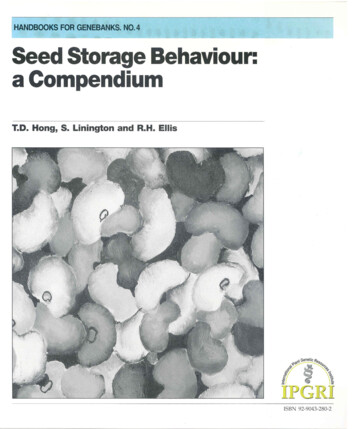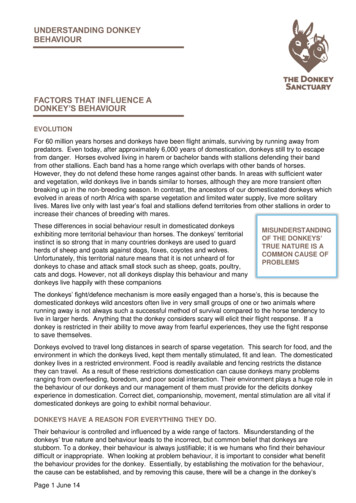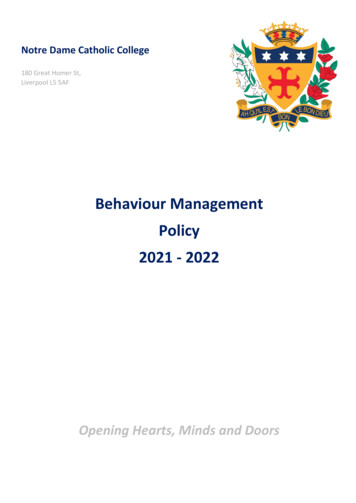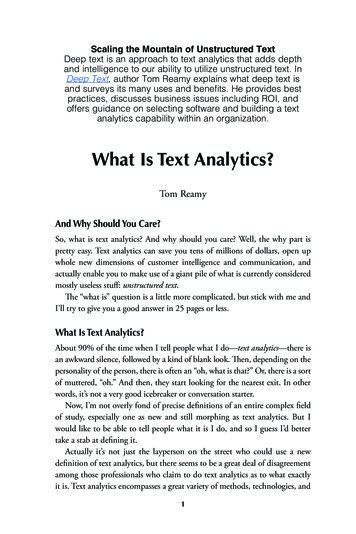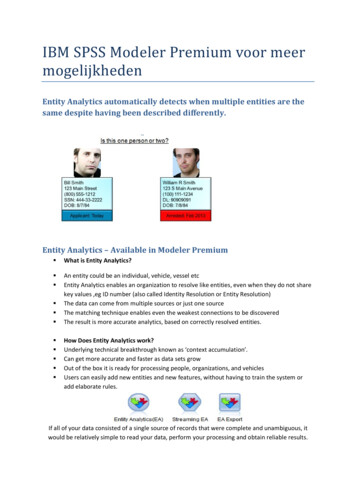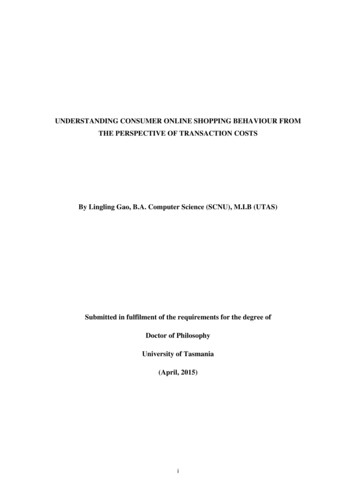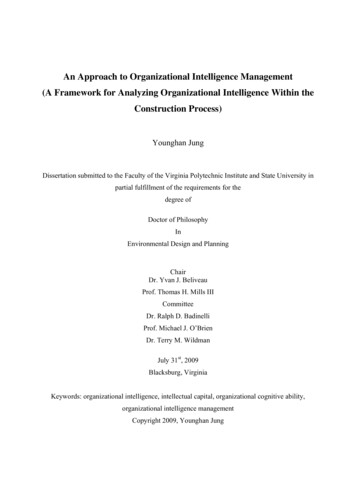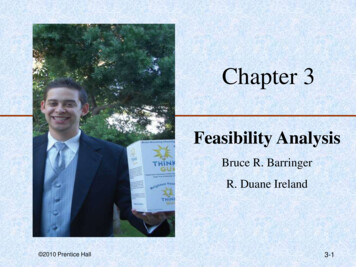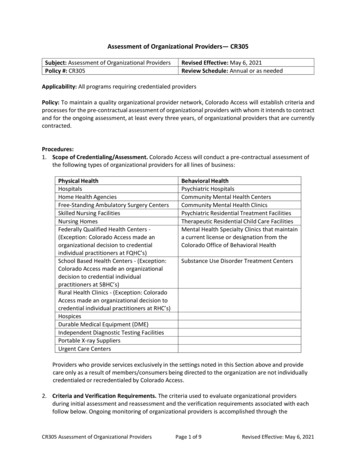
Transcription
David BuchananLeicester Business School, De Montfort UniversityAndrzej HuczynskiDepartment of Business and Management, University of GlasgowOrganizational Behaviour An Introductory Text:fifth edition. .
Outline contentsChapter 1Part 1Chapter 2Chapter 3Part 2Chapter 4Chapter 5Chapter 6Chapter 7Chapter 8Part 3Chapter 9Chapter 10Chapter 11Chapter 12Part 4ChapterChapterChapterChapter13141516Part 5ChapterChapterChapterChapter17181920Part 6ChapterChapterChapterChapter21222324PrologueThe organizational context31The world outsideTechnology3568Individuals in the ceptionMotivation107141178214241Groups and teams in the organ279Group formationGroup structureIndividuals in groupsTeamworking283317354387Organization structures423Traditional work designElements of structureEarly organization designOrganization strategy and design427460503537Organization processes573Organization developmentOrganizational changeOrganizational cultureHuman resource management577606641673Organization r and politics715753789827GlossaryReferencesName indexSubject index863883935947
Full contentsGuided tourText aims and target readershipAcknowledgementsChapter 1PrologueKey concepts and learning outcomesWhat is organizational behaviour?Why study organizational behaviour?A field map of the organizational behaviour terrainNatural and social sciencesRecap and RevisionSpringboard, Home viewing, OB in literature, Chapter exercisesPART 1Chapter 2Chapter 3xvixxixxxiii12710142627THE ORGANIZATIONAL CONTEXTInvitation to see (1)32The world outside35Key concepts and learning outcomesWhy study the world outside?Analyzing the organizational environmentThe continuing search for 'fit'The post-modern organizationPostmodernism: fresh perspectives on organizational behaviourRecap and RevisionSpringboard, Home viewing, OB in literature, Chapter exercises3535374854566263Technology68Key concepts and learning outcomesWhy study technology?Why technology predictions are often falseChanging the nature of work (1): teleworkingChanging the nature of work (2): call centresChanging the nature of work (3): employee surveillanceDeterminism or choice?The politics of technologyClassic studies on work and technologySocio-technical systems analysis and designTeam versus lean: competing socio-technical paradigmsRecap and RevisionSpringboard, Home viewing, OB in literature, Chapter exercises68687074788182848589949798
ContentsPART 2Chapter 4Chapter 5Chapter 6Chapter 7INDIVIDUALS IN THE ORGANIZATIONInvitation to see (2)104Learning107Key concepts and learning outcomesWhy study learning?The learning processThe behaviourist approach to learningThe cognitive approach to learningApplications: behaviour modification techniques in practiceApplications: socialization and feedbackBehaviour modification versus socializationThe learning organizationRecap and RevisionSpringboard, Home viewing, OB in literature, Chapter ity141Key concepts and learning outcomesWhy study personality?The definition problemTypes and traitsEmotional intelligenceThe big fivePersonality Types A and BStress management: individual and organizational methodsThe development of the selfNomothetic versus idiographic?Selection methodsRecap and RevisionSpringboard, Home viewing, OB in literature, Chapter mmunication178Key concepts and learning outcomesWhy study communication?A model of interpersonal communication: coding and decodingVerbal communication: conversation control and listening skillsThe significance of non-verbal communicationImpression management: form versus substance?Organizational communication: commitment and propagandaRecap and RevisionSpringboard, Home viewing, OB in literature, Chapter ey concepts and learning outcomesWhy study perception?Selectivity and organization in perceptionPerceptual sets and perceptual worldsDo we see to know or know to see?214214215221224
ContentsChapter 8PART 3Chapter 9Chapter 10Perceptual sets and assumptionsSex, appearance, attractiveness and discriminationPerson perception: errors and avoidanceRecap and RevisionSpringboard, Home viewing, OB in literature, Chapter exercises226229234235236Motivation241Key concepts and learning outcomesWhy study motivation?Drives, motives and motivationContent theories of motivationProcess theories of motivationThe social process of motivating othersEnrichment, high-performance systems and empowermentRecap and RevisionSpringboard, Home viewing, OB in literature, Chapter exercises241241243244251259266271272GROUPS AND TEAMS IN THE ORGANIZATIONInvitation to see (3)280Group formation283Key concepts and learning outcomesWhy study group formation?Definitions of groupsTypes of group taskThe Hawthorne studiesGroup-oriented view of organizationsFormal and informal groupsHomans' theory of group formationStages of group developmentGroups and teamsVirtual teamsRecap and RevisionSpringboard, Home viewing, OB in literature, Chapter oup structure317Key concepts and learning outcomesWhy study group structure?Group structurePower structureStatus structureLiking structureCommunication structureRole structureLeadership structureRecap and RevisionSpringboard, Home viewing, OB in literature, Chapter exercises317317318320321324328335341345346
xiiContentsChapter 11Chapter 12PART 4Chapter 13Chapter 14Individuals in groups354Key concepts and learning outcomesWhy study individuals in groups?The individual and the groupGroup influences on individuals' perceptionsGroup influences on individuals' performanceGroup influences on individuals' behaviourGroup influences on individuals' attitudesDeindividuationIndividual influences on group attitudes and behaviourRecap and RevisionSpringboard, Home viewing, OB in literature, Chapter ing387Key concepts and learning outcomesWhy study teamworking?The T-word and team job designTypes of teamAdvice teamsAction teamsProject teamsProduction teamsEcological framework for analyzing work team effectivenessRecap and RevisionSpringboard, Home viewing, OB in literature, Chapter TION STRUCTURESInvitation to see (4)424Traditional work design427Key concepts and learning outcomesWhy study traditional work design?Birth of scientific managementTaylorismFordismAfter Ford: the deskilling debateBack to the future?Recap and RevisionSpringboard, Home viewing, OB in literature, Chapter exercises427427428429438444452455456Elements of structureKey concepts and learning outcomesWhy study elements of structure?Organization structuringTypes of jobLine staff and functional relationshipsThe formal and the informal organizationDesign or evolution of structure460460460461463472475475
ContentsChapter 15Chapter 16PART 5Chapter 17Chapter 18XIIIRoles in organizationsOrganization structures and managerial rolesRecap and RevisionSpringboard, Home viewing, OB in literature, Chapter exercises485490497498Early organization design503Key concepts and learning outcomesWhy study early organization design?Max Weber and bureaucracyOrganizational rulesStrengths and weaknesses of bureaucratic organization structuresHenri Fayol and classical management theoryContingency approachContingency and technological determinismContingency and environmental determinismContingency and organizational sizeRecap and RevisionSpringboard, Home viewing, OB in literature, Chapter ization strategy and design537Key concepts and learning outcomesWhy study organization strategy and design?Corporate strategy and organization structureStrategic choice and environmentsBounded instability and non-linearityMarket, hierarchy and interorganizational relationshipsVirtual organizationRecap and RevisionSpringboard, Home viewing, OB in literature, Chapter exercises537537538543547550563567568ORGANIZATION PROCESSESInvitation to see (5)574Organization development577Key concepts and learning outcomesWhy study organization development?The OD agenda: goals and processesThe OD matrix: levels and modes of interventionOD techniques: the toolkitGrid Organization DevelopmentOD applications: the evidenceTo be an OD consultantRecap and RevisionSpringboard, Home viewing, OB in literature, Chapter nal change606Key concepts and learning outcomesWhy study organizational change?606606
XIVContentsChapter 19Chapter 20PART 6Chapter 2 1The paradoxical nature of changeStrategic change: the contemporary imperativeChange and the individualResistance to change: causes and management solutionsThe benefits and limitations of participative change managementN-step recipes for changeThe process and context of changeBusiness process re-engineeringThe expertise of the change agentRecap and RevisionSpringboard, Home viewing, OB in literature, Chapter tional culture641Key concepts and learning outcomesWhy study organizational culture?The rise of the organizational culture conceptCulture: surface manifestations, values and basic assumptionsOrganizational socializationPerspectives on culture contrastedOrganizational culture, performance and changeNational culturesRecap and RevisionSpringboard, Home viewing, OB in literature, Chapter exercises641642642643650654662663669670Human resource management673Key concepts and learning outcomesWhy study human resource management?Personnel: traditional rationale and imageTransformation: contemporary problems and solutionsModels of human resource managementCriticismsDoes it work?Is it new?Recap and RevisionSpringboard, Home viewing, OB in literature, Chapter N MANAGEMENTInvitation to see (6)712Leadership715Key concepts and learning outcomesWhy study leadership?Leadership versus managementTrait-spotting: the search for personality markersPower: what is it, and how can I get more?Jobs for the boys?Style-counselling: the search for effective behaviour patternscontext-fitting: the development of contingency theoriesLeadership in the twenty-first century715715718720723726730733741
ContentsChapter 22 :Chapter 23Chapter 24xvLeaders: do we need them?Recap and RevisionSpringboard, Home viewing, OB in literature, Chapter exercises746747748Decision-making753Key concepts and learning outcomesWhy study decision-making?Models of decision-makingDecision conditions: risk and programmabilityIndividual and group decision-makingProblems with group decision-makingOrganizational decision-makingRecap and RevisionSpringboard, Home viewing, OB in literature, Chapter exercises753753755765768770780785786Conflict789Key concepts and learning outcomesWhy study conflict?The sanitization of conflictContrasting frames of reference: unitarist, pluralist, interactionistCo-ordination failure and conflictConflict resolution methodsThe radical frame of referenceEmotional labourRecap and RevisionSpringboard, Home viewing, OB in literature, Chapter exercises789789791792796804814818822823Power and politics827Key concepts and learning outcomesWhy study power and politics?Power in organizationsPower tactics and influencing strategiesPolitics in organizationsPolitical behaviourPower and politics in the post-modern organizationRecap and RevisionSpringboard, Home viewing, OB in literature, Chapter ncesName indexSubject index863883935947
Chapter 10 Group structure Key concepts and learning outcomes Why study group structure? Group structure Power structure Status structure Liking structure Communication structure Role structure Leadership structure Recap and Revision Springboard, Home viewing, OB in literature, Chapter exercises 317 317 317 318 320 321 324 328 335 341 345 346

